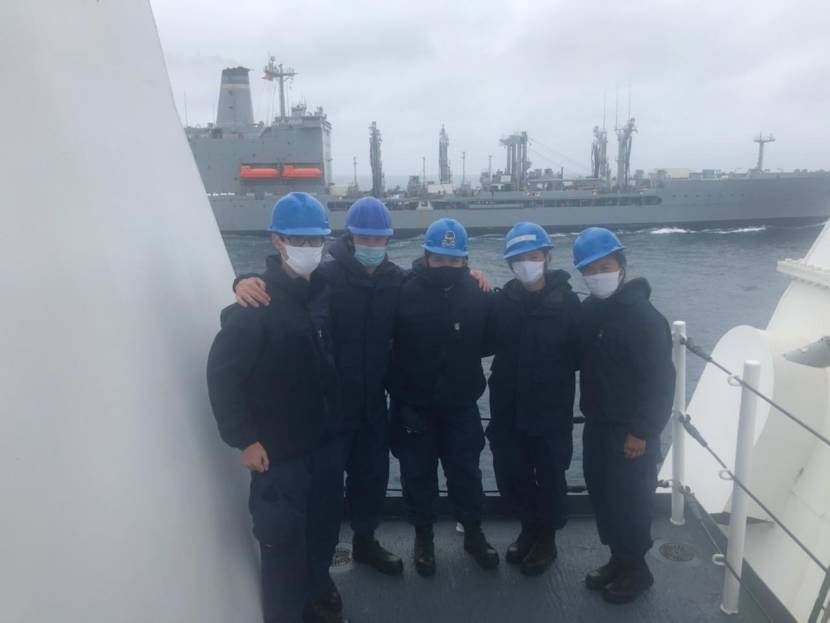
This summer, the COVID-19 pandemic threatened to scuttle the Alaska patrol of a U.S. Coast Guard cutter when over 10% of the crew was put in quarantine. But the ship’s mission was saved when a large group of cadets — the youngest, newest and most-inexperienced members of the Coast Guard — was called on to help.
To use a very old nautical phrase, Captain Blake Novak was caught between the devil and the deep blue sea.

Novak is commanding officer of the cutter Munro, one of the biggest vessels in the Coast Guard fleet at 418 feet.
The Munro was in Dutch Harbor this summer when Novak got word of a big storm heading their way. The weather forecast was so bad that Novak was advised to stay in port for the next four days. It would’ve been dangerous to get underway as the storm passed through the area.
“We were going to encounter 18-plus-foot seas off the beam,” Novak said.
If they stayed in port as advised, they would miss a planned military exercise off Hawaii. As Novak saw it, they had to leave.
But many of his crew were ashore for a barbecue celebration that included having a few beers.
“We call it the bottle-to-throttle policy, which says that you need to stop drinking 12 hours prior to getting the ship underway,” Novak said.
The Munro normally has 150 crew members. But many couldn’t help prepare the ship for departure because they had been drinking. So Novak turned to 16 cadets fresh from the U.S. Coast Guard Academy.

“The majority of our cadets were underage,” Novak said. “So, right away they were filling shoes and able to step in immediately to assist and assume those roles to help out with the crew.”
Novak says the cadets handled the ship’s lines so they could leave Dutch Harbor as soon as possible.
First Class Cadet Jordan Park says that turned out to be a long day.
“It was really great to be relied on in that way,” Park said. “I think it was a little bit tough because we had been up since pretty early that morning pulling in, and we expected to stay overnight. And then, not staying overnight and getting underway that night was a little bit challenging. But that’s how the Coast Guard is and it was cool to experience that.”
Novak says they then steamed at high speed for 48 hours to beat the weather and eventually get to Hawaii on time.
So many cadets serving aboard a Coast Guard ship is very unusual. But it’s an unusual year.

The Munro’s mission in the Bering Sea this summer included fisheries enforcement, search and rescue and patrolling the maritime boundary with Russia. But just before the ship left, Novak says they had an asymptomatic crewmember who tested positive for COVID-19. The crewmember and their close contacts, 18 people total, had to stay in quarantine.
So, Novak asked the Coast Guard Academy in New London, Connecticut for help. Many cadets were just returning from a summer break.
“In the military, we would say they were ‘voluntold,’” Novak said.
Novak says the arriving cadets were excited but understandably very nervous.
These cadets are essentially officers in training. And for two months, they filled roles normally held by enlisted service members just out of boot camp. Senior enlisted personnel trained the cadets to handle the lines for the ship, work in the mess, serve as lookouts and steer the ship.

Third Class Cadet Branyelle Carillo says she expected to be working hard.
“But we knew that it was going to be a great learning environment for the future and understanding what the fleet is actually about compared to us being here at school,” Carillo said.
And Carillo says they learned the importance of working as a team.
“You have to use other people that are around you in order to get what needs to be done,” Carillo said.
“So, that was like a biggest lesson of a lot of things that we did on (the) Munro.”
Novak, who considers his ship as a floating schoolhouse, says their experiences are important for any future leader, whether in the Coast Guard or elsewhere.
“These young men and women, in the future, are going to be put in positions where they’re managing our enlisted personnel,” Novak said. “So, for them to get a true feeling of what it’s like to walk and spend a day — in this case to spend two months — in the same shoes as our enlisted personnel, it’s very important from a leadership development standpoint.”
Not only did all the cadets have a unique experience, they also received a Meritorious Team Commendation that is usually only awarded to regular Coast Guard personnel. The Coast Guard Academy says it’s rare for these cadets, some a little over a year out of high school, to wear such a red ribbon on their uniform before they even graduate from the Academy.
